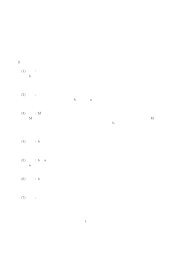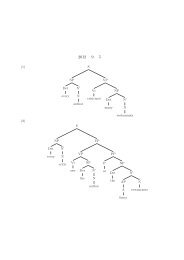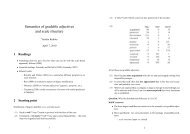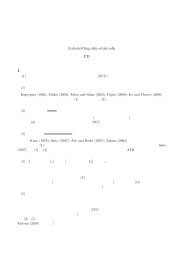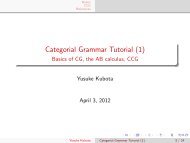日英語の結果構文におけるスケール構造と事象構造の同型性
日英語の結果構文におけるスケール構造と事象構造の同型性
日英語の結果構文におけるスケール構造と事象構造の同型性
You also want an ePaper? Increase the reach of your titles
YUMPU automatically turns print PDFs into web optimized ePapers that Google loves.
∗<br />
<br />
1 <br />
<br />
<br />
<br />
( 1996, Washio 1997, )<br />
<br />
boundedness<br />
constraint<br />
( 2006,<br />
2009, )Kennedy and Levin (2008),<br />
Beavers (2010) <br />
<br />
<br />
<br />
Talmy (2000) path conflation<br />
<br />
2 /<br />
<br />
<br />
(i) <br />
(ii) <br />
Wechsler (2005)<br />
Washio (1997) <br />
2.1 <br />
Krifka (1992, 1998) (1) <br />
incremental theme<br />
<br />
homomorphism<br />
(1) a. John ate an apple {in/??for} an hour. (telic)<br />
b. John ate apples {*in/for} an hour. (atelic)<br />
incremental theme <br />
telic <br />
incremental theme <br />
atelic <br />
<br />
Wechsler (2005) <br />
<br />
*1 <br />
<br />
∗ wuegaki@gmail.com<br />
*1 (i) <br />
fake<br />
maximal endpoint<br />
<br />
telic <br />
<br />
Wechsler <br />
*2 <br />
boundedness<br />
constraint (2) <br />
hammer <br />
flat, straight <br />
long, wide, thin, beautiful <br />
(3a) <br />
<br />
(3b) completely <br />
perfectly <br />
cf. e.g., Kennedy and McNally 2005<br />
(2) He hammered the metal {flat/straight/*long/*wide/<br />
*thin/*beautiful} (cf. Green 1972)<br />
(3) a. flatter/straighter/longer/wider/thinner/<br />
more beautiful<br />
b. completely/perfectly {flat/straight/<br />
#long/#wide/#thin/#beautiful}<br />
Wechsler Boas (2000) <br />
<br />
* 3<br />
<br />
<br />
(<br />
2006, Tanaka 2008, 2009, 2009)<br />
(4a, 5a) <br />
<br />
<br />
(4b, 5b) <br />
<br />
(4) a. <br />
(i)<br />
reflexive<br />
a. The runners ran the pavement thin.<br />
b. Ann shouted herself hoarse.<br />
*2 Vanden Wyngaerd (2001) <br />
*3 Wechsler <br />
telic <br />
(2007b) <br />
4
. *John stretched the rubber long.<br />
(5) a. <br />
b. *John brought up his son tough.<br />
(6) a. # { / }<br />
b. # completely {long/tough}<br />
<br />
<br />
telic <br />
(7) <br />
(8)<br />
imperfective paradox;<br />
Dowty 1979<br />
(7) a. { /?? } <br />
b. { /?? } <br />
(8) a. <br />
<br />
b. <br />
<br />
<br />
<br />
telic <br />
<br />
<br />
<br />
Krifka-Wechsler <br />
<br />
<br />
<br />
<br />
Washio (1997)<br />
<br />
2.2 <br />
Washio (1997) <br />
<br />
weak resultativesstrong resultatives<br />
<br />
(9) <br />
theme<br />
<br />
(10) <br />
<br />
<br />
(9) (weak resultatives)<br />
a. Mary froze it solid.<br />
b. <br />
c. Mary wiped the table clean.<br />
d. { /<br />
/ }<br />
(10) (strong resultatives)<br />
a. The horse dragged the logs smooth.<br />
b. * { / } <br />
<br />
c. She kicked her son black and white.<br />
d. *<br />
e. The jockeys raced the horses sweaty.<br />
f. *<br />
g. They beat the man bloody.<br />
h. *<br />
Washio (9) <br />
<br />
(10) <br />
<br />
/<br />
(10) <br />
<br />
Washio <br />
<br />
<br />
<br />
<br />
<br />
disposition to change<br />
telic <br />
(9d) / <br />
(4a) <br />
<br />
(11) <br />
(12) <br />
telic<br />
(13) cool widen <br />
degree achievements; Dowty 1979<br />
<br />
(11) a. { / } <br />
/ <br />
b. {?/ } <br />
(12) a. { / } <br />
⇒ { / }<br />
b. <br />
⇒ <br />
(13) a. John cooled the soup {in/for} ten minutes.<br />
b. John was cooling the soup ⇒ John has cooled<br />
the soup.<br />
2 <br />
<br />
<br />
<br />
4 <br />
2.1 <br />
2.2
3 <br />
<br />
(1996) LCS<br />
(1996) <br />
(15) [BEat<br />
z] <br />
(14) <br />
(CAUSE) [BECOME . . . ] <br />
<br />
<br />
(14) [x ACT-ON y]<br />
(15) [x ACT-ON y] CAUSE [y BECOME [BE-AT z]]<br />
<br />
<br />
<br />
<br />
<br />
BECOME telic <br />
<br />
<br />
(2009) BECOME <br />
BE-AT <br />
atelic <br />
telic <br />
BE-AT <br />
<br />
<br />
BECOME <br />
BE-AT <br />
BECOME LCS telic <br />
(2009) <br />
(15) <br />
LCS <br />
* 4<br />
(2007b)<br />
Tanaka (2008) CAUSE <br />
telic <br />
PATH <br />
PATH <br />
*4 <br />
<br />
(cf. Tanaka 2008) (4a) <br />
<br />
(ii)<br />
(i) <br />
<br />
(i)<br />
(ii)<br />
a. <br />
b. <br />
a. <br />
b. *<br />
telic <br />
<br />
CAUSE <br />
telic <br />
<br />
telic <br />
<br />
telic <br />
<br />
<br />
(10) <br />
telic <br />
<br />
-Tanaka <br />
<br />
<br />
<br />
<br />
<br />
4 <br />
Kennedy and Levin (2008) Beavers<br />
(2010) <br />
<br />
<br />
<br />
<br />
<br />
<br />
<br />
<br />
<br />
<br />
<br />
<br />
<br />
Wechsler <br />
<br />
(10) <br />
<br />
<br />
<br />
hammer<br />
the metal flat flat <br />
hammer <br />
<br />
<br />
<br />
<br />
<br />
<br />
<br />
(9)
4.1 <br />
<br />
<br />
event predicateθ <br />
Krifka (1998) strict<br />
incrementalitySINC<br />
(16) strict incrementality:<br />
SINC D (θ) ≔ MAP-UD(θ) ∧ MAP-UE(θ)<br />
(17) (sub-degree) :<br />
MAP-UD(θ) iff ∀x, d, e, e ′ [θ(x)(d)(e) ∧ e ′ < e →<br />
∃!d ′ [θ(x)(d ′ )(e ′ ) ∧ d ′ < d]]<br />
(18) (sub-event) :<br />
MAP-UE(θ) iff ∀x, d, d ′ , e[θ(x)(d)(e) ∧ d ′ < d →<br />
∃!e ′ [θ(x)(d ′ )(e ′ ) ∧ e ′ < e]]<br />
(16) (19) <br />
flat <br />
(19) [[flat]] = λxλdλe. flat(x)(d)(e) <br />
a. flat(x)(d)(e) = 1 iff x is flat to the degree d in<br />
the final part of e * 5<br />
b. SINC D (flat)<br />
(20) hammer <br />
Type shifter<br />
RESL (21) (19) <br />
hammer the metal flat (22)<br />
<br />
(20) [[hammer]] = λxλe. hammer(x)(e)<br />
(21) :<br />
RESL E = λ f λxλgλe. f (x)(e) ∧ ∃d[g(x)(d)(e)]<br />
*5 λxλdλe. flat(x)(d)(e) e <br />
x flatness degree d e x flatness<br />
degree d ′ (26a)<br />
stretched <br />
(22) [[hammer the metal flat]]<br />
= RESL E ( [[hammer]])( [[the metal]])( [[flat]])<br />
= λe. hammer(the metal)(e)∧∃d[flat(the metal)(d)(e)]<br />
(22) (23) <br />
(23) <br />
telic <br />
<br />
(23) VP <br />
non-homogenous event:<br />
∀ f, x, g, e[RESL( f )(x)(g)(e) →<br />
∀e ′ [e ′ > e → ¬HOM(e ′ , λe.RESL( f )(x)(g)(e))]]<br />
HOM(e, θ) ≔ ∀e ′ , e ′′ ≤ e[θ(e ′ ) ∧ θ(e ′′ )]<br />
e <br />
e ′ e ′ <br />
<br />
non-homogenous<br />
event<br />
<br />
<br />
<br />
<br />
<br />
long <br />
<br />
<br />
<br />
(23) <br />
<br />
(24) VP <br />
e <br />
e ′ (24) <br />
<br />
(24) λe. hammer(the metal)(e) ∧<br />
∃d[long(the metal)(d)(e)]<br />
e ′ (17) <br />
<br />
(24) <br />
(24) <br />
(23) <br />
<br />
(22) <br />
<br />
flatness<br />
<br />
e e ′ <br />
e ′ e <br />
(22) e ′ <br />
e ′ flatness<br />
<br />
(22) <br />
(23)
telic <br />
telicity <br />
(23) <br />
Wechsler (2005) telic <br />
<br />
(2007b) British National<br />
Corpus <br />
(2007b) (2009) telic <br />
<br />
(25) a. I froze the ice cream (very) hard.<br />
b. She opened the door very wide.<br />
4.2 <br />
<br />
(16) <br />
(23) <br />
<br />
<br />
<br />
(26)<br />
degree argument<br />
strict incrementality<br />
<br />
(26) [[]] = λxλdλe. stretched(y)(d)(e)<br />
a. stretched(x)(d)(e) = 1 iff x is stretched to the<br />
degree d in the final part of e<br />
b. SINC D (stretched)<br />
(27) positive morpheme<br />
pos (Kennedy and McNally 2005, Kennedy 2007)<br />
x e <br />
(28)<br />
stnd <br />
<br />
(27) [[]] = λxλdλe. long(x)(d)(e)<br />
(28) pos( [[]]) = λxλe. long(x)(stnd(long))(e)<br />
(29) <br />
<br />
(21) <br />
(29) <br />
<br />
(29) RESL J = λ f λgλxλe. ∃d[g(x)(d)(e)] ∧ f (x)(e)<br />
VP<br />
<br />
(30) [[]]<br />
= RESL J ( [[]])(pos( [[]]))<br />
= λe. ∃d[stretched(rubber)(d)(e)] ∧<br />
long(rubber)(stnd(long))(e)<br />
<br />
<br />
<br />
<br />
<br />
<br />
(30) <br />
<br />
<br />
<br />
<br />
*6 (31) <br />
<br />
<br />
<br />
(31) #<br />
<br />
<br />
(23) <br />
<br />
<br />
(23) <br />
<br />
dimension<br />
<br />
<br />
<br />
<br />
<br />
2.2 <br />
<br />
(10) <br />
4.3 Incremental theme<br />
/<br />
(32-33) <br />
<br />
(32) John painted the wall red.<br />
(33) <br />
<br />
<br />
incremental theme<br />
<br />
<br />
<br />
(32) <br />
<br />
(33) <br />
<br />
<br />
<br />
(33)<br />
*6 stnd <br />
<br />
<br />
(Kennedy 2007)
INCR<br />
ext <br />
(34) INCR = λ f λxλdλe.∃x ′ [ f (x ′ )(e) ∧<br />
ext(x ′ )/ext(x) = d∧∀x ′′ [ f (x ′′ )(e) → x ′ ≮ x ′′ ]]<br />
<br />
*7 RESL<br />
<br />
INCR<br />
<br />
(35) INCR([[]]) = λxλdλe.∃x ′ [painted(x ′ )(e) ∧<br />
ext(x ′ )/ext(x) = d ∧ ∀x ′′ [painted(x ′′ )(e) → x ′ ≮ x ′′ ]]<br />
5 <br />
<br />
<br />
<br />
<br />
<br />
<br />
<br />
<br />
Washio (1997) <br />
<br />
<br />
<br />
<br />
<br />
<br />
Talmy (2000) <br />
<br />
<br />
satellite<br />
<br />
<br />
<br />
<br />
<br />
<br />
<br />
Talmy<br />
<br />
<br />
Beavers, J. (2010). “Aspectual Classes and Scales of<br />
Change”. Ms, University of Texas at Austin. [available<br />
online].<br />
*7 <br />
e.g, pos INCR <br />
<br />
Boas, H. C. (2000). Resultative Constructions in English<br />
and German. PhD thesis, University of North Carolina.<br />
Dowty, D. R. (1979). Word Meaning and Montague Grammar:<br />
The Semantics of Verbs and Times in Generative<br />
Semantics and in Montague’s PTQ. Reidel.<br />
Green, G. (1972). “Some Observations on the Syntax and<br />
Semantics of Instrumental Verbs”. In CLS 8, 83–97.<br />
(1996). –. <br />
.<br />
Kennedy, C. (2007). “Vagueness and grammar: the semantics<br />
of relative and absolute gradable adjectives”. Linguistics<br />
and Philosophy, 30(1):1–45.<br />
Kennedy, C. and B. Levin (2008). “Measure of Change:<br />
The Adjectival core of degree achievements”. In L. Mc-<br />
Nally and C. Kennedy, (eds), Adjectives and Adverbs:<br />
Syntax, Semantics and Discourse. OUP, 156–182.<br />
Kennedy, C. and L. McNally (2005). “Scale structure and<br />
the semantic typology of gradable predicates”. Language,<br />
81(2):345–381.<br />
(2009). <br />
<br />
. In () (2009), 315–364.<br />
Krifka, M. (1992). “Thematic relations as links between<br />
nominal reference and temporal constitution”. In I. Sag<br />
and A. Szabolcsi, (eds), Lexical Matters. CSLI, 29–53.<br />
Krifka, M. (1998). “The Origins of Telicity”. In S. Rothstein,<br />
(ed), Events and Grammar. Kluwer, 197–235.<br />
(2006). –<br />
. .<br />
(2009). . In<br />
() (2009), 141–170.<br />
() (2007a). . <br />
.<br />
(2007b). <br />
. In () (2007a), 67–101.<br />
() (2009). . <br />
.<br />
Talmy, L. (2000). Toward a Cognitive Semantics, Vol. 2:<br />
Typology and Process in Concept Structuring. The MIT<br />
Press.<br />
Tanaka, E. (2008). “The notion of path in aspectual composition:<br />
Evidence from Japanese”. In J. Dölling and<br />
T. Heyde-Zybatow, (eds), Event Structures in Linguistic<br />
Form and Interpretation. Mouton, 199–222.<br />
Washio, R. (1997). “Resultatives, Compositionality and<br />
Language Variation”. Journal of East Asian Linguistics,<br />
6:1–49.<br />
Wechsler, S. (2005). “Resultatives under the ‘Eventargument<br />
homomorphism’ model of telicity”. In<br />
N. Erteschik-Shir and T. Rapoport, (eds), The Syntax of<br />
Aspect. OUP, 255–273.<br />
Vanden Wyngaerd, G. (2001). “Measuring Events”. Language,<br />
77(1):61–90.



